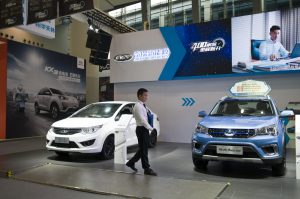After competing over high-speed rail, China and Japan are now increasingly competing with each other over Indonesia’s growing automotive market. Last week it was reported China’s Chery Automobile Co. Ltd. has announced that it is ready to re-enter Indonesia this year, after an abortive attempt to break into the market in the early 2000s, this time with a promise of fresher and more sophisticated products.
“In the next two years, we will present five new models in Indonesia, namely conventional SUVs and new energy vehicles,” said Qin Gang, a representative of Chery, as reported by KONTAN newspaper. Chery is also investing in a production facility in Indonesia.
Chery is not the only Chinese auto manufacturer to make inroads in Indonesia. Wuling and Dongfeng Sokonindo (DFSK) are also increasingly prominent in the nation’s car market. Wuling’s cars are now sold through more than 100 dealer networks across the nation.
KONTAN reports that the popularity of Wuling’s products has now exceeded sales from Japanese car brands such as Mazda and Nissan. From January to June of this year, Wuling recorded 10,973 units sold, giving the Chinese firm a 2.8 percent share of the Indonesian auto market and making it the seventh most popular car brand in the country. DFSK has also recorded healthy sales, although not quite as substantial as Wuling.
While some believe that Chinese products will face difficulties in converting Indonesian consumers from the Japanese brands with which they have long been familiar, Chinese manufacturers are starting to learn how to win the hearts of Indonesians, especially by recognizing their need for reliable after-sales service assurance.
From a Chinese perspective, Indonesia is a promising automotive market for two reasons. First, the ratio of car ownership to total population remains low, standing at just 99 cars per 1,000 people as of this year, meaning that there is considerable room for the industry to grow. Second, Indonesia has recently seen the substantial development of vital infrastructure including roads and highways, which are likely to stimulate demand for cars.
As a matter of fact, Chinese carmakers have been making inroads in Indonesia for some time. In 2019, after President Joko Widodo signed a presidential regulation on electric cars, the Indonesian government announced that it was reportedly planning to collaborate with Chinese manufacturers to this end. Shortly afterward, in July 2019, two Chinese companies, BYD Auto Co., Ltd and JIC, announced plans to relocate their operations to Indonesia.
Moreover, the same month, DFSK also announced its intention to produce its E3 Glory electric cars in Indonesia, with the intention of marketing them across Southeast Asia.
As the world’s largest source of car and electric vehicle sales, China’s entry into Indonesia’s car market stands to disrupt Japan’s long-standing dominance of Indonesia’s automotive industry.
Since the 1970s, Indonesian consumers have relied heavily on Japan when it comes to cars. The Association of Indonesia Automotive Industries reported in 2016 that most cars driven in Indonesia are made in Japan. CNN also conducted polling which found that Indonesians prefer Japanese cars over those produced in Europe, South Korea, or China. Japanese carmakers such as Toyota and Honda have also begun to market electric vehicles in Southeast Asia.
But given that electric vehicles are both new to Indonesia and relatively expensive, Chinese brands enjoys a certain advantage. Compared to their Japanese rivals, many people view cars from China as relatively cheap and of comparable quality. Moreover, China is now the world’s leading producer of electric vehicles, as well as a leader in the manufacture of many of the components that go into them.
China, which had 93 battery factories as of last year, has privileged access to required materials such as nickel, cobalt, and lithium. It is also a home to production plants of the cathodes, anodes, and chemicals crucial to producing battery cells.
CATL, China’s largest producer of lithium-ion batteries, is planning to establish a production site for the component in Indonesia in 2024. Meanwhile, two of the world’s most crucial plants for nickel processing, the Weda Bay Industrial Park and Morowali Industrial Park, are located in Indonesia, both of which are majority owned by Chinese firms.
It thus makes sense for Indonesia to eye stronger cooperation with China on both the sale and production of cars and electric vehicles.
The growing entry of Chinese car makers into Indonesia’s auto market is likely to disrupt the stability of its long-time economic cooperation with Japan. This is especially the case if we consider the fact that Indonesia has increasingly become a strategic battleground between Beijing and Tokyo, such as in the recent bidding for the construction of a railway between Jakarta and Bandung, whereby China succeeded in winning the bid.
While Indonesia recently said it was considering bringing in Japan to help extend the rail line to Surabaya, at the time the initial bid was announced, the Japanese government, which had made a number of preparations to secure the bid, was disappointed at the outcome, as then Chief Cabinet Secretary Suga Yoshihide said at the time. Considering this recent development, Indonesia’s automotive market looms as yet another battleground between the two East Asian rivals.

































